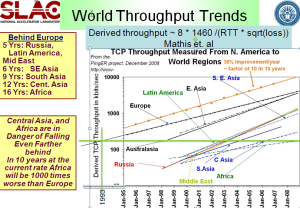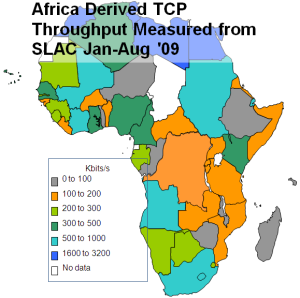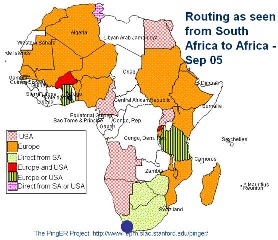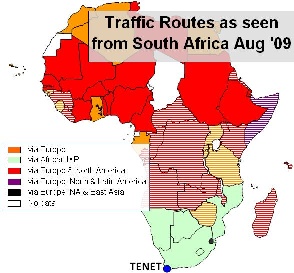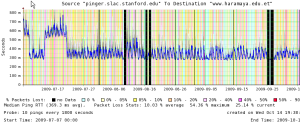...
<ac:structured-macro ac:name="unmigrated-wiki-markup" ac:schema-version="1" ac:macro-id="e4876010b0960853-b2ad775d-467a4cab-8fb3886c-475d65cdd4236f0d6592416b"><ac:plain-text-body><![CDATA[ | Throughput from SLAC to Regions of the World | Derived Throughput from SLAC to Africa Jan-Aug '09 [[xlsx | ^africa-thru-aug09.xlsx]] | MinRTT from SLAC - Aug. 2009 [[xls | ^map-africa-minrtt-aug2009.xls]] | ]]></ac:plain-text-body></ac:structured-macro> |
|---|---|---|---|---|---|---|
|
|
|
...
<ac:structured-macro ac:name="unmigrated-wiki-markup" ac:schema-version="1" ac:macro-id="3b530393feff1fae-95ce70a5-41994438-9c2ab428-07a77efb2c3c90178e5a902c"><ac:plain-text-body><![CDATA[ | Routing from South Africa to African Countries (Sep '05) | Routing from South Africa to African Countries (Aug '09) [[xls | ^routing-africa-aug2009.xls]] | Routing from Burkina Faso to African Countries (Aug '09) [[xls | ^routing-africa-aug2009.xls]] | ]]></ac:plain-text-body></ac:structured-macro> |
|---|---|---|---|---|---|---|
| |
|
...
Between the 22nd and 25th of September the RTT from SLAC to The Kigali Institute of Education host www.kie.ac.rw dropped by a factor of 2 from 720msec to 320msec (see below). The connection was through Uganda to Kenya. The traceroute appears to go via Austria.
In some cases such as Uganda Telecom (81.199.21.194) the losses and fluctuations in RTT went up dramatically after the changeover. In others such a library.uonbi.ac.ke and acherarchitects.co.ke the losses and stability appeared to improve.
...
For example on May 19th 2009, www.novagest.co.ao one of 4 sites PinGER monitors in Angola reduced the average RTT from about 750ms to 450ms and became much more stable (less jitter) in the process (see the time series in the figure below). The traceroute goes via Globenet TATA Communications and then to the Angola Telecom IP backbone.
THe RTT from SLAC to www.haramaya.edu.et at the University of Addis Ababa in Dire Dawa, Ethiopia's second largest city (about 300km as the crow flies from the coast) dropped from about 580ms to 300ms on June 9th 2009 (see below).
Similarly the average RTTs of both hosts that PingER monitors in Mozambique (www.uem.mz and www.micti.co.mz) dropped from 780ms to about 360 ms in May Similarly the average RTTs of both hosts that PingER monitors in Mozambique (www.uem.mz and www.micti.co.mz) dropped from 780ms to about 360 ms in May 2007.
On the other hand hosts in Namibia (such as www.adsl.com.na seen below) seem to be switching between using a long RTT path from SLAC and a shorter one.
Malawi currently (10/13/09) has only GEOS access. The most likely terrestrial path will be via Mozambique to Maputo (the landing point for both Seacom and TEAMS) see the email from Bjorn Pehrson and the article by Telegeography.
One host (www.aisha.ac.zm) of the 6 monitored in Zambia improved its RTT from about 720ms to 550ms on August 20, 2009 (see below). Also at the time of writing it looks like they are still moving the link over to the terrestrial lines since the performance is very unstable (high losses) and there are big changes in RTT. It is possible the link in one direction is using a GEOS while the other is an all terrestrial link and the large dips to 400ms are when both legs are using terrestrial links. We believe the terrestrial path goes via Botswana and Namibia. The traceroute from SLAC on 9/9/09 appeared to use a satellite link in at least one direction. On October 2, 2009 Mike Jensen reported that the traceroute from Rome to www.aisha.ac.zm was well below 450ms and thus appears to be a terrestrial link. However the tracreoute from SLAC was still taking over 550ms. Also the traceroute from TENET/Cape Town South Africa to www.aisha.ac.zm took over 650ms. The traceroute from NUST, Islamabad, Pakistan to mail.unza.zm takes less than 450ms and appears to be a terrestrial path going via Namibia. On October 7th 2009 the traceroute from SLAC to mail.unza.zm appeared to be terrestrial and went via Namibia.
The RTT to one host www.kie.ac.rw in Rwanda at the Institute of Information reduced from about 720ms to 360ms between the 22nd and 26th of Spetember 2009.
Malawi currently (10/13/09) has only GEOS access. The most likely terrestrial path will be via Mozambique to Maputo (the landing point for both Seacom and TEAMS) see the email from Bjorn Pehrson and the article by Telegeography. On October 7th 2009 the traceroute from SLAC to mail.unza.zm appeared to be terrestrial and went via Namibia.
Angola: www.novagest.co.ao | Ethiopia: www.haramaya.edu.et | Namibia: www.adsl.com.na | Zambia Rwanda: www.aishakie.ac.zm Rwandarw | ||
|---|---|---|---|---|---|
| |
| | ||
Zambia: www. | kieaisha.ac. | rw zm |
|
|
|
|
|
|
|
Other Regions in Sub-Saharan Africa
...
